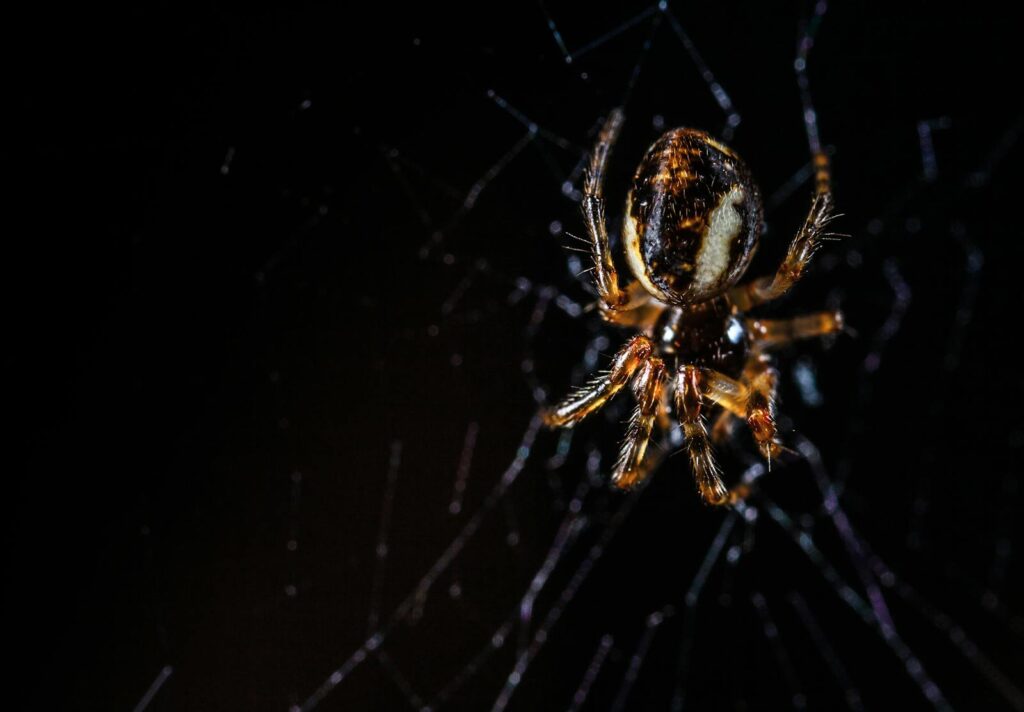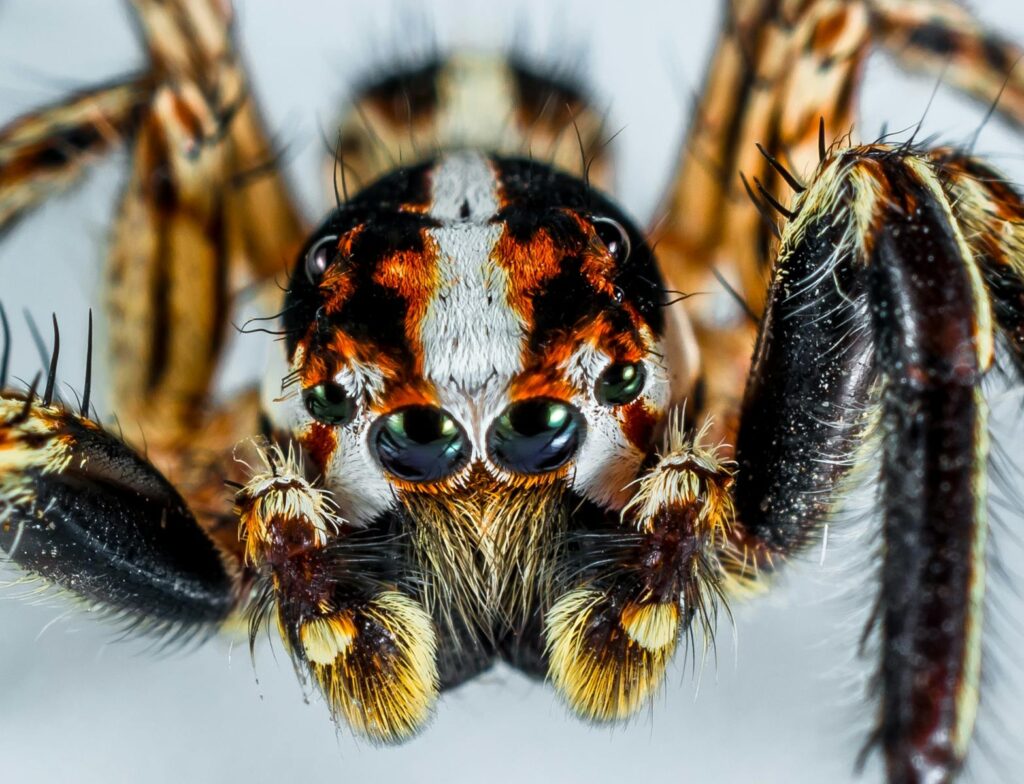In the fascinating world of arachnids, predatory strategies range from the straightforward to the remarkably deceptive. Among these master tricksters, one non-venomous spider has developed an extraordinary hunting technique that exemplifies the ingenuity of evolution. The Portia spider, a member of the jumping spider family (Salticidae), employs a sophisticated form of mimicry by creating fake vibrations that lure unsuspecting prey directly into its clutches. This remarkable predator demonstrates that in nature, intelligence and deception can be just as effective as venom or brute strength. Through a complex understanding of its prey’s behavior and remarkable problem-solving abilities, the Portia spider has carved out a unique ecological niche that continues to fascinate scientists and nature enthusiasts alike.
The Remarkable Portia Spider: An Introduction

The Portia spider belongs to the genus Portia in the jumping spider family, a group renowned for their exceptional vision and intelligence among arachnids. Despite measuring only about 5-10mm in length, these spiders possess cognitive abilities that rival those of much larger animals. Their appearance is rather unassuming—with a brownish, textured body that resembles leaf litter or detritus—providing excellent camouflage in their natural habitat. Native to tropical forests across Africa, Asia, and Australia, Portia spiders have developed specialized hunting techniques that set them apart from typical ambush predators. Unlike many spiders that rely on venom to quickly immobilize prey, the Portia compensates for its relatively weak venom by employing elaborate hunting strategies that take advantage of other spiders’ instincts and behaviors.
Exceptional Intelligence in a Tiny Package

What makes the Portia spider truly exceptional is its remarkable brain power, especially considering its minuscule size. Scientists have documented problem-solving abilities in these spiders that seem improbable for creatures with brains smaller than a pinhead. They can plan complex hunting routes, sometimes taking detours of up to an hour to approach prey from an advantageous angle. Research has shown that Portia spiders can improvise and adapt their hunting strategies when faced with novel situations, demonstrating a level of cognitive flexibility typically associated with vertebrates. Their central nervous system, though tiny, contains a proportionally large number of neurons dedicated to processing visual information and planning complex behaviors. This cognitive sophistication allows them to assess potential prey and develop appropriate hunting tactics on the fly, making them one of the most intelligent invertebrates on the planet.
The Spider-Hunting Spider

In an intriguing evolutionary twist, Portia spiders have specialized in hunting other spiders, a behavior known as araneophagy. This dietary preference is unusual in the spider world and presents unique challenges, as their prey consists of fellow predators with their own defensive capabilities. Portia spiders regularly target web-building spiders, jumping spiders, and even other predatory arachnids like wolf spiders. This dangerous dining preference has driven the evolution of their sophisticated hunting techniques, as approaching another spider requires stealth and strategy. By specializing in hunting other spiders, Portia has accessed an abundant food source that many predators avoid, reducing competition for resources. Their araneophagy has led to an evolutionary arms race, pushing the development of increasingly sophisticated deception tactics to overcome the defenses of their spider prey.
The Art of Vibratory Mimicry

At the heart of the Portia spider’s hunting arsenal is its remarkable ability to perform vibratory mimicry—creating fake vibrations that mimic specific signals meaningful to its prey. When approaching a web-building spider, Portia will delicately pluck and manipulate the silk strands, producing vibration patterns that mimic various scenarios. These deceptive signals might imitate a small insect struggling in the web, a potential mate, or even wind disturbance—whatever will most likely draw out the web’s owner. The precision of these fake vibrations is astonishing, with Portia able to adjust the frequency, amplitude, and pattern to match the expectations of different spider species. This mimicry requires not just mechanical skill but also a sophisticated understanding of how different prey species interpret web vibrations, suggesting a form of cognitive empathy previously thought impossible in invertebrates.
A Versatile Repertoire of Deceptive Signals

The Portia spider’s vibratory repertoire extends far beyond a single deceptive signal, encompassing a diverse range of mimicry patterns tailored to different prey species. When hunting the spitting spider Scytodes, Portia will create vibrations mimicking a small insect trapped at the web’s edge, carefully avoiding patterns that might trigger a defensive response. For other species, it might simulate the distinctive courtship vibrations of a male spider, luring a receptive female directly into its ambush. Research has documented individual Portia spiders using up to 20 different vibratory patterns, switching between them if one approach proves ineffective. This trial-and-error methodology suggests not only innate behavioral programming but also a capacity for learning and adapting to feedback. The spider’s ability to customize its approach based on the target species demonstrates a remarkable specialization rarely seen in invertebrate predators.
The Hunting Sequence: Patience and Precision

A typical hunting sequence for the Portia spider exemplifies the extraordinary patience that complements its deceptive abilities. Upon encountering another spider’s web, Portia will first observe the owner and web structure, sometimes remaining motionless for extended periods while assessing the situation. Once it identifies the target, it begins creating targeted vibrations by plucking web strands with its legs or palps, sometimes continuing this deception for hours until the prey responds appropriately. If the target spider approaches to investigate the disturbance, Portia freezes briefly before launching a precisely timed attack, grabbing the prey with its front legs. The entire hunting sequence can take anywhere from minutes to several hours, reflecting an investment of time and energy that would be impractical for less intelligent predators. This methodical approach allows Portia to successfully capture prey that would otherwise be too dangerous to approach directly.
Vision: The Foundation of Portia’s Hunting Success

Underpinning the Portia spider’s hunting prowess is its exceptional visual system, which stands out even among jumping spiders known for their keen eyesight. Their main eyes provide sharp, color vision with a level of acuity remarkable for such a small creature, allowing them to distinguish fine details of potential prey from distances up to 30 body lengths away. Unlike most spiders that rely primarily on touch or vibration sensing, Portia uses its vision to identify prey species and plan appropriate hunting strategies before making any contact. Secondary eyes positioned around their head provide nearly 360-degree awareness of movement, helping them detect both prey and potential threats. This visual capability allows them to study their prey’s behavior from a safe distance, gathering crucial information that informs their mimicry tactics. The combination of sharp vision and cognitive processing enables the complex decision-making that makes their hunting strategy possible.
Learning and Memory Capabilities

Perhaps most surprising about the Portia spider is evidence suggesting significant learning and memory capabilities that enhance its hunting success. Laboratory studies have shown that Portia spiders can remember effective hunting tactics for particular prey species and apply this knowledge in future encounters. They demonstrate the ability to learn from failed hunting attempts, adjusting their approach when a particular vibratory pattern proves ineffective with a specific prey species. Research indicates they can retain this learned information for at least a week, suggesting a form of long-term memory previously unexpected in arachnids. This capacity for learning allows individual Portia spiders to develop specialized expertise in hunting certain prey types through experience. The combination of innate hunting behaviors with this learning capability creates a predatory approach that continually improves throughout the spider’s lifetime.
Specialized Prey Preferences and Adaptations

Different Portia species and even populations within species often display specialized preferences for particular prey types, reflecting local adaptations to available food sources. Portia labiata in the Philippines, for instance, has developed specific tactics for hunting spitting spiders, while populations in Sri Lanka focus more on web-building species. These specializations can be reflected in subtle anatomical differences, such as leg length or body size, that provide advantages when hunting preferred prey types. Geographic variations in hunting tactics suggest that Portia populations undergo local adaptation to the most common spider species in their habitat. Research has revealed that isolated populations can develop distinct “dialects” of vibratory signals tailored to the specific prey species they commonly encounter. This specialization demonstrates how natural selection can fine-tune predatory behavior at surprisingly local scales.
The Evolutionary Advantages of Deception Over Venom

The Portia spider’s evolution of sophisticated deception rather than powerful venom represents a fascinating evolutionary trade-off with several advantages. By relying on intelligence and mimicry rather than toxicity, Portia avoids the metabolic costs of producing and maintaining potent venom glands, redirecting that energy toward neural development and reproduction. This strategy allows them to target prey that might have evolved resistance to common spider venoms, accessing food sources unavailable to typical predators. The deceptive approach also reduces the risk of injury during prey capture, as targets are often already positioned for an optimal attack before they realize the danger. Additionally, this strategy minimizes the evolutionary pressure on prey species to develop specific defenses against Portia, since the mimicry constantly evolves and adapts. The success of this approach demonstrates that in evolutionary terms, brains can sometimes prove more advantageous than brawn or biochemical weapons.
Challenges to Scientific Understanding

Studying the complex behavior of Portia spiders presents significant challenges to researchers attempting to understand the cognitive mechanisms behind their hunting strategies. The small size of their nervous system makes traditional neuroscience approaches difficult, leaving scientists to infer cognitive processes from observable behaviors rather than direct neural recordings. Distinguishing between innate, programmed behaviors and genuine problem-solving remains a central challenge in interpreting their apparent intelligence. Laboratory studies may not fully capture the complexity of their behavior in natural environments, where they face a much wider range of prey species and situations. Despite these challenges, research on Portia spiders continues to push the boundaries of our understanding of invertebrate cognition and has forced scientists to reconsider assumptions about the neural requirements for complex behavior. The study of these remarkable predators blurs traditional distinctions between “simple” invertebrate behaviors and the cognitive abilities previously attributed only to vertebrates.
Conservation and Future Research Directions

As tropical forests face increasing threats from deforestation and climate change, the specialized habitats that support Portia spiders are similarly at risk. Conservation efforts focused on preserving intact forest ecosystems indirectly benefit these remarkable arachnids and the complex ecological relationships they represent. Future research on Portia spiders is likely to incorporate advanced techniques like miniaturized neural recording to better understand the neural basis of their decision-making processes. Comparative studies across different Portia species may reveal how these complex behaviors evolved and diversified over evolutionary time. The study of these spiders continues to offer valuable insights into the evolution of intelligence, the neural basis of complex behavior, and the remarkable adaptability of predator-prey relationships. As technology advances, our understanding of these tiny masterminds will likely deepen, potentially revealing even more sophisticated cognitive abilities than currently recognized.
Conclusion

The Portia spider stands as a testament to nature’s ingenuity, demonstrating that even creatures with minuscule nervous systems can evolve remarkably sophisticated behaviors. Through its mastery of vibratory deception, this small arachnid has carved out a successful ecological niche that would otherwise be inaccessible. The spider’s ability to create fake vibrations that manipulate the behavior of its prey represents one of the most complex forms of mimicry known in the animal kingdom, challenging our understanding of what constitutes intelligence and how it evolves. As research continues to unravel the mechanisms behind the Portia spider’s remarkable abilities, it serves as a humbling reminder that intelligence in nature takes many forms, and that even the smallest brains can harbor surprising capabilities when shaped by evolutionary pressures. In the ongoing dance of predator and prey, the Portia spider has developed an approach that proves brains can be mightier than venom.

